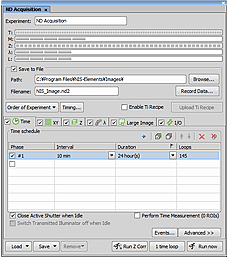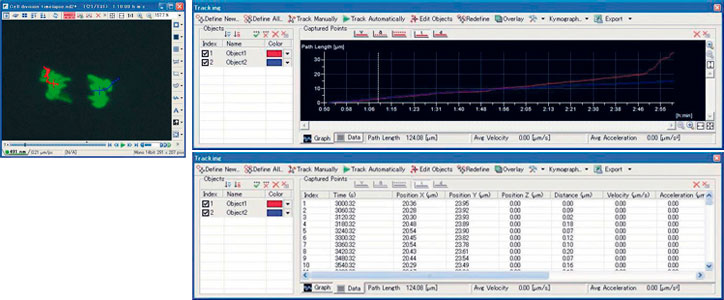Imaging Software NIS-Elements
Never before has a software package achieved such recognition for comprehensive device control with a suite of image analysis, visualization and archiving tools.
Nikon's NIS-Elements revolutionizes imaging software for the microscopy market by combining automated intelligence to microscopes, cameras, components and peripherals with powerful archiving, analysis and visualization tools. Its intuitive interface simplifies workflow and speeds up image acquisition times while providing powerful features such as image stitching, object counting and volume views.
Overview

The NIS-Elements software suite is composed of three distinct packages scaled to address specific application requirements. Each version delivers an intuitive interface to simplify workflow and provides powerful imaging tools. The software supports numerous image analysis and processing routines in conjunction with useful tools for storing and retrieving image data.
NIS-Elements AR (Advanced Research)
NIS-Elements AR is optimized for advanced research applications. It features fully automated acquisition and device control through full six-dimensional image acquisition and analysis.
The software is designed to deliver power and maximize workflow. It handles multi-dimensional imaging flawlessly, with support for capture, display, peripheral device control and data management and analysis of up to six dimensions (X, Y, Z, Lambda (wavelength), T, multi stage points). It also offers sophisticated image processing and visualization features, such as a 5D viewer, automated object counting, intensity measurements over time, image stitching, deconvolution, databasing and Extended Depth of Focus functions.
The system contributes to experiment efficiency with a database building feature developed to handle archiving and searching of large numbers of multi-dimensional image files.
Unified control of the entire imaging system offers significant benefits to users for cutting-edge research, such as live cell imaging.
NIS-Elements BR (Basic Research)
NIS-Elements BR is suited for standard research applications such as analysis and photodocumentation of fluorescent imaging. It features up to four dimensional acquisition capabilities and advanced device control capabilities.
While not as full featured as the AR package, BR offers access to advanced image capture, archiving and analysis solutions that are easy to use and provide maximum workflow.
BR handles multi-dimensional imaging with ease, with support for capture, display, peripheral device control, and data management and analysis of up to four dimensions (for example: X, Y, Z, Lambda (wavelength)). It also provides advanced image processing features, such as automated image count, intensity over time, database capabilities and report generation, and Extended Depth of Focus functions.
The system contributes to experiment efficiency with a database building feature developed to handle archiving, searching, and analysis of large numbers of multi-dimensional image files. Unified control of the entire imaging system offers significant benefits to users for cutting-edge research, such as live cell imaging.
NIS-Elements D (Documentation)
NIS-Elements D is tailored to facilitate image capture, object measurement and counting, databasing and report generation. Ease of use and simplification of menu options has been emphasized in the design of the package while NIS-Elements AR and BR also display a similar look and feel.
The combination of integrated automated intelligence, streamlined workflow, attention to detail and creative design makes NIS-Elements D the perfect package for clinical and industrial applications such as tissue comparison, image archiving and reporting, particle analysis, defect analysis and fiber & textile material analysis.
Core documentation functionality includes manual length and area measurements as well as large imaging stitching. Optional modules are available: database for streamlined image filing; retrieval and report generation for PDF based reports; Extended Depth of Focus (EDF), which creates an all-in-focus image from a series of Z-axis images; live compare for comparing a live image with a static image or overlay; Automatic Measurement for automated object counting using thresholding, feature restrictions and data export; and advanced macro builder for more complex custom programming.
NIS-Elements C (Confocal Imaging)
NIS-Elements C is an optimized software package for confocal imaging. It is compatible with high-speed/high-resolution confocal microscope A1+/A1R+, multiphoton confocal microscope A1 MP+/A1R MP+, confocal microscope C2+ and spectral confocal imaging systems.
Its intuitive GUIs enable complicated sequences of experiments, such as multidimensional time-lapse imaging and photoactivation, to be carried out with simple-to-use settings. All settings and procedures required for basic confocal microscopy can be viewed in a single window.
In addition, various functions, such as filtering, averaging and image compensation, for image processing and analysis are provided.
NIS-Elements HC (High-Content Analysis)
NIS-Elements HC supports total operation of high-content analysis, from integrated control of motorized inverted microscope Ti-E and peripheral devices such as well plate loaders and CCD cameras, to image data management. Nikon’s newly developed software interface is specifically designed for imaging multiple points within a well and across a well plate, and works with dedicated automated analysis modules.
- Settings for well plate acquisition: several options are available for number of points, randomization and patterns, and acquisition parameters.
- Cell count, live/dead analysis and image intensity: analysis for the purpose of generating measurement data, either during acquisition or post-acquisition.
- Cell count: automated counting of cellular objects such as nuclei or other organelles
- Live/dead: analyzes the number and percent of living and dead cells by discriminating between live and dead cell populations using two fluorescent colors, thus showing cell viability.
- Sample labeling: links acquired images and complex experimental conditions, such as cell type labels, control wells and drug dose quantities or concentrations.
- Plate view: a centralized view of image thumbnails. Quick access to analysis results is available with the Heat Map and Grid View functions.
- Heat map: a customizable, graphical, color or intensity representation of analysis results well by well. A powerful tool used to visualize trends across the well plate.
- Grid (text view):displays individual image analysis results. Filtering and exporting data to several formats such as Excel are possible.
Multidimensional Capturing (Option)

NIS-Elements can combine X, Y, Z, Lambda (wavelength), Time, and Multi Stage Points within one integrated platform for multi-dimensional imaging (depends on the capability of the software). All combinations of multidimensional images can be linked together in one ND2 file sequence using an efficient workflow and intuitive GUI. (NIS-Elements AR: up to 6D, NIS-Elements BR: up to 4D)
2D Deconvolution (Option)
The 2D deconvolution module enables the user to observe live specimens with less blur. It allows faint biological processes to be observed that may otherwise be missed and increases observed signal-to-noise ratio. (NIS-Elements AR)


3D Deconvolution (Option)
The haze and blur of the image that can occur when capturing a thick specimen or a fluorescence image can be eliminated from the captured 3D image. (NIS-Elements AR)

Before deconvolution

After deconvolution
Calcium & FRET (Option)
This plug-in allows calcium measurement and FRET analysis. FRET analysis uses the three-filter method and allows calibration of Ca2+ concentration. The Gordon method that uses three filter sets allows calculation of FRET efficiency. (NIS-Elements AR)


Object Tracking (Option)
By tracking an object captured by 2D acquisition, speed and distance of its movement can be measured. Exporting acquired data is also possible. (NIS-Elements AR)

Object Classifier (Option)

Extracted measurement objects can be classified according to shape, brightness, size and specified characteristics. Measuring and counting by each class can be conducted easily. (NIS-Elements AR)
Extended Depth of Focus (Option)

With the Extended Depth of Focus (EDF) module, images that have been captured in a different Z-axis can be used to create an all-in focus image. Also, it is possible to create stereovision images & 3D surface images to achieve virtual 3D imaging. (NIS-Elements AR/BR/D)
Database Capabilities (Option)

NIS-Elements has a powerful image database module that supports image and meta data. Various databases and tables can easily be created and images can be saved to the database via one simple mouse-click. Filtering, sorting and multiple grouping are also available according to the database field given for each image. (NIS-Elements AR/BR/D)
